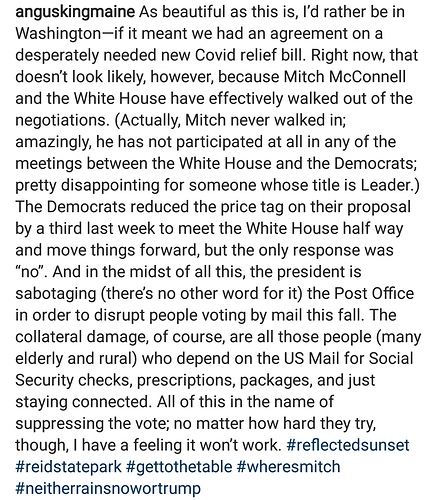Responses from Sunday media on Executive Powers which T hopes to usurp any failed negotiations with Dems/R’s who are at a stalemate on renegotiating a Relief Bill.
Dana Bash CNN takes on Larry Kudlow - Economic Advisor/mouthpiece for WH/former Fox guy
and she stops him from saying that evictions can not be halted by President, not ironclad, only suggestions.
And Kudlow trying to explain how the States will add to the unemployment fees from their budgets.
CNN’s Dana Bash sparred with White House economic adviser Larry Kudlow on Sunday over the temporary unemployment plan included in President Trump’s coronavirus executive orders, saying: “We need a bit of a reality check here.”
Bash questioned Kudlow on CNN’s “State of the Union” about the Trump order that commits $400 per week in temporary unemployment benefits, $100 of which the state would picks up.
Kudlow predicted that individuals, on average, will receive $800 from federal and state enhanced unemployment benefits each week.
“But the executive action says 400 dollars and the state would pay 25 percent of this,” Bash replied. “You’re talking about some other money that I don’t know about.”
“We will stand ready to repurpose if states put in a little bit more,” the economic adviser replied.
.@DanaBashCNN presses WH economic adviser Larry Kudlow on President Trump’s latest executive order addressing federal unemployment benefits which says cash-strapped states must pay 25% of $400 unemployment or federal add-on benefit won’t kick in. https://cnn.it/2F7tPgp #CNNSOTU pic.twitter.com/X489W0j16r
— State of the Union (@CNNSotu) August 9, 2020
Bash continued by saying: “We need a bit of a reality check here. You do agree that the only way any of this could possibly happen is if the states actually ask for it and create a whole new system?”
The CNN host also pushed Kudlow on how the administration knows states have the money to provide $100 per week to each unemployed person.
“I think they’ll be able to make room,” he said. “Our estimates from the Treasury Department in terms of the CARES Act … is that the states have not spent all the money that was allocated to them.”
“Based on our estimates, the states will be able to provide the extra $100 and that will gross up the whole benefit to something on average of about $800,” he added.
Kudlow also said the White House will “probably find out today and tomorrow” which states and territories will be able to afford the payment.
“At the moment, we know the money – probably a good $80 [billion] to $100 billion – was not spent so we think that’s distributed across the 50 states should be ample,” he added. “We’ll find out the exact specifics today and tomorrow.”
Best explainer here…from this daily newsletter from Heather Cox Richardson
Today’s announcement that Trump was providing economic relief through executive action after Congress failed to pass a coronavirus bill was an attempt to drive a narrative that will give Trump an issue for the upcoming election.
The story is this: On May 15, the House of Representatives, controlled by Democrats, passed a $3 trillion coronavirus relief bill, known as the HEROES Act, short for Health and Economic Recovery Omnibus Emergency Solutions Act. It provided relief for workers, protected renters, shored up cratering state budgets, funded emergency changes to the 2020 election, and supported hospitals and schools.
Senate Majority Leader Mitch McConnell (R-KY) refused to take it up. In an interview on the Fox News Channel, he said "We will let you know when we think the time is right to begin to move again.” That time was apparently not until the end of July, just as federal funding for a supplement to unemployment benefits ran out and a moratorium on evictions ended.
Then, with unemployed Americans facing a wall and the economy facing a cliff, Senate Republicans began to negotiate their own coronavirus relief package, but it became clear quickly that they could not agree. Senators up for reelection wanted popular measures that would help their constituents; others opposed further federal spending. Unable to come up with a plan, McConnell bowed out of further negotiations.
That left House Speaker Nancy Pelosi (D-CA) and Senate Minority Leader Chuck Schumer (D-NY) negotiating with Treasury Secretary Steven Mnuchin and White House chief of staff Mark Meadows. The administration officials proposed $1 trillion in aid, and cutting out state support and election funding, among other things. When the Democrats yesterday offered to compromise on a $2 trillion bill, the White House rejected it out of hand.
This opened the way for Trump to step in.
This evening, from his golf club at Bedminster, New Jersey, Trump signed three memorandums and one executive order that bypass Congress to provide the relief the White House wanted. Trump said these measures would provide economic relief for struggling Americans by providing temporary benefits, deferring taxes, and by ending evictions.
It is not clear the measures will do any such thing.
The Constitution establishes that only the House of Representatives can initiate a revenue bill, so Trump cannot come up with new money. Tonight’s memo on relief relies on Trump’s emergency powers. It calls for the Federal Emergency Management Agency (FEMA) to use about $70 billion from the Department of Homeland Security’s Disaster Relief Fund (DRF) to provide an additional $300 of unemployment benefits weekly. But since the law requires states to kick in 25% matching funds for expenditures from the DRF, the memo also calls on states to use their allocation of the $80 billion still unspent from the earlier coronavirus CARES Act to put an additional $100 weekly into relief, for a total of a $400 weekly supplement to state unemployment benefits. Trump has also told states to identify funds they can spend if the DRF falls to $25 billion.
States are struggling from the collapse of tax revenues due to the pandemic. They are facing major layoffs and program cuts. Republicans oppose shoring them up apparently with the hope of forcing the states into a restructuring that will cut social benefits. The requirement in this memo will stress them more.
It is also unclear how long the DRF’s money will hold out, since more than 30 million Americans are currently collecting unemployment benefits.
Another of Trump’s memos relies on the law that gives the Treasury Secretary leeway to delay tax filing and collection in case of disasters. Trump directs the Treasury Secretary to defer payroll taxes for workers making less than about $100,000 a year, starting on September 1. Members of both parties disliked this idea, but it has long been one of Trump’s favorite provisions. He insists it will inject money into the economy, although there is argument over that.
The taxes would still be due, just not until next year. But Trump appears to want to end them altogether. Trump’s lawyer Jenna Ellis tweeted “This is actually the biggest news of the day: President Trump said that if he is re-elected, he will look into terminating the payroll tax permanently!”
It is the payroll tax that funds Social Security and partly funds Medicare.
Another memo extends the deferral of student loan payments set up under the CARES Act until December 31. Under the earlier act, it expired in September.
Like the payroll tax memo, the “Executive Order on Fighting the Spread of COVID-19 by Providing Assistance to Renters and Homeowners” starts by noting that the coronavirus began in China and from there reiterates some of Trump’s favorite claims about the success of his administration. Then the memo notes how hard-hit people of color have been by Covid-19, and points out that POC are at most danger of eviction. But the memo does not, in fact, provide anything to stop that process. It simply asks various administration officials to consider whether anything can be done to help.
So what’s the story behind these four executive actions, announced late Saturday, just in time to make it onto all the Sunday talk shows?
McConnell may have sat out the negotiations because he knew he could never get Republican senators to agree on a bill. But by pulling Republicans out of negotiations, he set up a narrative that pitted Democrats against the Trump White House. The White House refused to negotiate, cut off talks, and now Trump has declared that he has the power to fix the problem himself.
But it is not at all clear that he does have the power to reallocate funds as he has. Under the Constitution, Congress controls spending, and the president is supposed to execute the laws Congress writes. Congress allocated the money that he now wants to use for pandemic relief for other purposes.
So there will almost certainly be pushback on Trump’s actions on legal grounds. But, with Senate Republicans out of negotiations, Republicans can frame legal pushback as Democrats objecting to the relief Americans so desperately need, even though the Democrats have been pushing for a relief bill for almost three months, and it is the Republicans who have been unable to produce one.
Her sources
Memorandum: https://www.whitehouse.gov/presidential-actions/memorandum-authorizing-needs-assistance-program-major-disaster-declarations-related-coronavirus-disease-2019/
https://www.whitehouse.gov/presidential-actions/memorandum-continued-student-loan-payment-relief-covid-19-pandemic/
https://www.whitehouse.gov/presidential-actions/executive-order-fighting-spread-covid-19-providing-assistance-renters-homeowners/
https://www.whitehouse.gov/presidential-actions/memorandum-deferring-payroll-tax-obligations-light-ongoing-covid-19-disaster/
https://abcnews.go.com/Politics/trump-sign-executive-orders-coronavirus-relief/story
payroll tax: https://www.ssa.gov/news/press/factsheets/HowAreSocialSecurity.htm
https://www.nytimes.com/live/2020/07/23/business/stock-market-today-coronavirus
https://www.nytimes.com/interactive/2020/us/coronavirus-us-cases.html
state revenue: https://www.npr.org/2020/08/03/893190275/states-are-broke-and-many-are-eyeing-massive-cuts-heres-how-yours-is-doing#bottom
https://www.npr.org/2020/07/26/895480905/millions-face-housing-crisis-after-federal-moratorium-on-evictions-expires
 Coronavirus (Community Thread)
Coronavirus (Community Thread)




